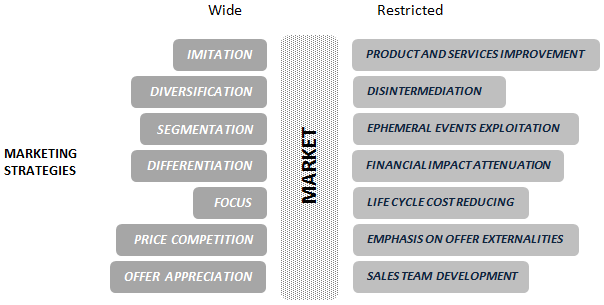A critical part of an enterprise’s planning is its marketing strategies because they define the offerer’s relationship with its market.
Marketing strategies are articulated lines of action involving controllable marketing variables aiming to satisfy the customers’ needs and desires in the most profitable way possible.
As stated in another post, the marketing strategies scope can be wide or restricted.
Wide-ranging marketing strategies comprise all or almost all of the offerer’s controllable marketing variables: product mix, sales force, distribution channels, pricing, and advertising and sales promotion. Instead, restricted-range marketing strategies are limited to just one or a few variables as the product-price composite.
The main wide-ranging marketing strategies are (1) imitation, (2) differentiation, (3) diversification, (4) segmentation, (5) focus, (6) price competition, and (7) offer appreciation.
As strategies of restricted scope, we have (1) product and services improvement, (2) disintermediation, (3) ephemeral events exploitation, (4) financial impact attenuation, (5) life cycle cost reduction, (6) emphasis on offering externalities, and (7) sales team development, as shown in the figure below.

Despite this particularization, one needs to consider that a provider can use several wide-range and restricted-range strategies at the same time.
For example, a soft drink manufacturer can opt to imitate the market-leading competitor (wide-range strategy) and center on sales team development (restricted-ranging strategy). Another competitor, in turn, may choose to improve its line product (restricted-range strategies) associated with focusing on a market niche (wide-range strategy) such as natural beverages.
C. L. Eckhard, author of Pricing in Agribusiness: setting and managing prices for better sales margins.











 Claudio Luiz Eckhard is a former professor, business consultant, and author of the books “Ajustando o Rumo”[Adjusting the Business Course], “Gestão pela Margem”[Management by Margin], “A Empresa Saudável”[The Healthy Company], and “Pricing no Agribusiness”[Pricing in Agribusiness].
Claudio Luiz Eckhard is a former professor, business consultant, and author of the books “Ajustando o Rumo”[Adjusting the Business Course], “Gestão pela Margem”[Management by Margin], “A Empresa Saudável”[The Healthy Company], and “Pricing no Agribusiness”[Pricing in Agribusiness].


